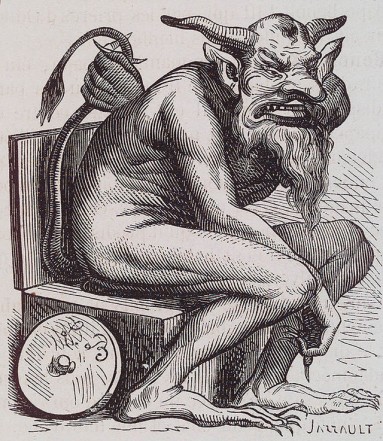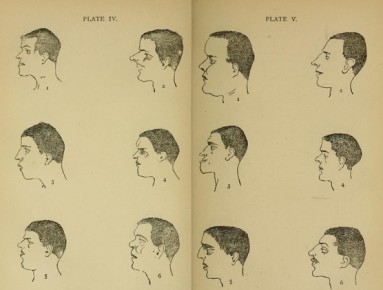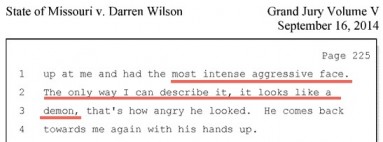"Now these criminals are recognised even from their earliest days because they have extraordinary anomalies of the face and of the skull, asymmetry, macrocephaly, exaggeration of the length or breadth, strabismus, ears badly placed or too large, enormous jaws, bad conformation of the teeth, especially of the incisors, now too large, and again too far apart, nose flat and crooked, hair abundant on the forehead, an exaggerated development of the body (a child of seven having the stature and weight of one of nine), strength precocious, left-handedness more common, and above all great dulness of the senses. There is then a criminal type, so that your intuition leads you unconsciously to shrink from a person who has the face of a thief. I explain this fact scientifically..."
—Cesare Lombroso, "Criminal Anthropology Applied to Pedagogy," The Monist, 1895, p. 57
"Do they know how those bullets hit my son? What they did to his body as they entered his body?"
? ? ?
Demons are god-like, yet feared because they take the place of a legitimate deity.
Medieval demonology cast them as unsparing figures to whom sacrifices were made instead of worshipping God.
From the Middle Ages right through the European Renaissance, their physiognomy corresponds to the moral repugnance they arouse, like the demon-figure Belphégor in the Dictionnaire Infernal.
As Kelly Hurley's The Gothic Body elaborates, belief in the body's mutable boundaries hardened by the eighteenth, nineteenth, and twentieth centuries. That "morphic variability," in which the demon-human is "continually in danger of becoming not-itself, becoming other," colluded with the rise of anthropological criminology, which produced deviance in physiognomic features.
The face charts "scientifically" presented by criminologists like Cesare Lombroso and Havelock Ellis demonstrate this tendency.
A demon's face, like all faces, is a product of its age. And never has the face been more of a battleground than in the racialized expression of state violence in a liberal-democratic empire.
The transcript of the Grand Jury investigation of Officer Darren Wilson's killing of Michael Brown reads like a flip book jumping between the demonological past and the criminological present.
It's not Wilson's culpability that is on trial, but Michael Brown's face.
Wilson's account of Brown is almost entirely focused on the encounter between their faces.
Wilson's own, doughy and subtly reddened in hospital photos, looking like he's emerged unscathed from a bad hangover, is submitted as evidence of his victimhood.
Photos of Brown's post mortem face is not publicly admissible evidence; in any case, the medical examiner failed to photograph Brown's body ("My battery in my camera died.")
All I see is his head, and that's what I shot
He was just staring at me, almost like to intimdate me or to overpower me
The intense face he had was just not what I expected from any of this
Wilson claims he told Brown to "get the fuck back," but instead Brown allegedly hit the side of his face "with a fist." The attention paid to the detail about Brown's proximity to Wilson's face is excruciating.
There was a significant amount of contact that was made to my face
Wilson alleges that dispensing mace on Brown wasn't an option because Brown was covering his face:
The chances of [mace] being effective were slim to none. His hands were in front of his face, it would have blocked the mace from hitting him in the face
And he contradicts himself by issuing another reason, that macing Brown would have left Wilson's own face unprotected:
I considered using my mace, however, I wasn't willing to sacrifice my left hand, which is blocking my face to go for it
Wilson's description of Brown's face as "demon"-like requires scrutiny (even as it invites revulsion).
He looked up at me and had the most intense aggressive face
While Wilson didn't waste a single breath in painting Brown as a "Hulk Hogan" to his shrimpy "five-year old," he projects Brown as having looked up at him. (Both men measure at 6'4'').
And that's when he lays on the most damning part of his testimony, that Michael Brown had a demon face.
The only way I can describe it, it looks like a demon, that's how angry he looked
The "it" is Brown's face, a non-human entity intermixing with human emotional characteristics. In The Gothic Body, Hurley calls this the abhuman.
And the face that he had was looking straight through me, like I wasn't even there, I wasn't even anything in his way
In the same breath as when he mentions the "demon" face Wilson allows,
He comes back towards me again with his hands up
The crucial and illicitly overlooked phrase in this sentence is "with his hands up."
Throughout the testimony Wilson clings to a portrait of the killer-cop as ghost, whitely transparent, spooked out, and hollow in contrast to a bulky, angry, unpredictable it-figure.
It's at this point that Wilson says he cocked and shot his gun with the bullet that would kill an unarmed (defenseless) Brown squarely in the head.
When he fell, he fell on his face
I remember his feet coming up... and then they rested
When it went into him the demeanor on his face went blank, the aggression was gone, it was gone, I mean I knew he stopped, the threat was stopped
The threat was stopped.
The only questioning of Darren Wilson's own face is painfully and comically debased. Asked about the supposed bruises to his face, both the prosecution and Wilson display confusion about what even constituted the injury.
Q: Now, what are we looking at there?
That's the left side of my face
Q: So you had, describe what we are looking at?
I can't really tell from that.
Q: Okay.
I can't see from this angle.
Q: Let me let you look at it again.
I think there was swelling to my face in that area too. I never saw my face after, this is the first I've seen.
Q: Does it look like swelling? You know your face better than we do, does it look like swelling?
I can't tell with that angle with the ruler.
Q: You can't tell on that one? What about this one?
That one I can tell from down by my, down in this area looks swollen to me.
Wilson's invisible bruises are nauseatingly pawed over. Brown's face, unphotographed but cast in retrospective narrative by his killer, is left questionably demonized (the prosecution never takes issue with Wilson's freakish account).
Finally, Wilson concedes that his killing of Brown was a foregone conclusion. In any other secret court proceeding, were the defendant not a police officer, this testimony could likely be used as evidence of premeditated murder; Wilson's gun was (passively) "presented as a deadly force option" when his face was threatened.
Q: In your mind him grabbing the gun is what made the difference where you felt you had to use a weapon to stop him?
Yes. Once he was hitting me in the face, that was enough, was in my mind to authorize the use of force
Q: Okay. So if he would not have grabbed your gun while he was hitting you in the face, everything was the same, but he would not have grabbed your gun, you still would have used deadly force?
My gun was already being presented as a deadly force option while he was hitting me in the face
Wilson's characterization of the community surrounding the killing scene (what the prosecution called "folks that lived in that apartment") is of an equally fear-inducing, if not totally demonic, body.
It is an antipolice area for sure
That community doesn't like the police
[I]t is a hostile environment
It bears noting that the origin of the term "abhuman" (which Hurley dissects in her book) is with William Hope Hodgson's The Night Land (1912).
Hodgson used "abhuman" to name species of intelligent beings evolving from humans that breed with alien beings, adapting to their deteriorating or decaying physical environment. The "abhuman" were maligned by denizens of the Last Redoubt who managed to artificially preserve their human characteristics, "though they were not fit for the new environmental conditions."
The only way I can describe it, it looks like a demon
And the face that he had was looking straight through me, like I wasn't even there
All I see is his head, and that's what I shot
Between the lines of Wilson's stupefying scenario (his ghost to Brown's demon) is a stark material and psychic landscape (his preservation to the community's unraveling) matching the reality of a deeply hateful and segregating world, one that includes and transcends Ferguson.



